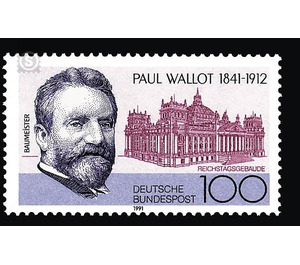150th birthday of Paul Wallot - Germany / Federal Republic of Germany 1991 - 100 Pfennig
Theme: Architecture
| Country | Germany / Federal Republic of Germany |
| Issue Date | 1991 |
| Face Value | 100.00 |
| Color | white violet blue |
| Perforation | K 14 |
| Printing Type | combined intaglio and offset printing |
| Stamp Type | Postage stamp |
| Item Type | Stamp |
| Chronological Issue Number | 1409 |
| Chronological Chapter | GER-BRD |
| SID | 838255 |
| In 44 Wishlists | |
The architect Paul Wallot comes from a Huguenot family that was expelled from France after the abolition of the Edict of Nantes in the 17th century and settled in the Rhineland. He was born on June 26, 1841 in Oppenheim am Rhein, on the paternal vineyard. His education received Paul Wallot especially in Hesse, where he moved to the Realschule (until 1856), the higher vocational school in Darmstadt (1856-1859). This was followed by varied academic years, beginning in the winter semester 1859/60 at the Politechnikum in Hanover (specializing in mechanical engineering). In the following three years Wallot was enrolled at the Berlin Bauakademie, but moved briefly to the Polytechnic to Munich and was also active in Hesse as a construction manager. Finally, in the winter semester of 1863/64, he passed the master construction examination at the School of Architecture of Giessen University. The forms of the Schinkel Neoclassicism practiced by the Berlin Bauakademie and its teachers as well as the resulting Bauateliers did not accord him much. Wallot sought a freer direction, which he finally found on a study trip to Italy and England. He left Berlin to settle in Frankfurt am Main as a private architect. On a second study trip to Italy, which he undertook in 1872, he immersed himself completely in the intellectual world of the Italian Renaissance; In particular, he studied the architecture Palladio, to which some buildings Wallots, especially the facades of the Reichstag building, remember. Wallot had hardly emerged in his field when he was only forty-one years old at the second competition for the Berlin Reichstag building in 1882 received nineteen of twenty-one awards judges for his design, leaving behind 188 other architects from around the world. But during the ten-year construction period at the Reichstag building, Paul Wallot was forced several times to correct his plans. The Reichstag Construction Commission initially demanded some changes in the layout of the rooms. A technical opinion of the Academy of Civil Engineering brought the lowering of the meeting room and a greater emphasis on the main floor, resulting in the present front of the Republic Square with the fourteen-meter-high columns, the interposed arched windows and the mighty outside staircase. In this form, the Reichstag on June 9, 1883, the project and transferred to Wallot also the execution. Emperor Wilhelm I had laid the foundation stone on June 9, 1884 in the presence of Bismarck, who himself read the founding charter. Wilhelm II. Took on 5 December 1894 in the central room of the foyer of the new Reichstag building, the solemn laying stone before. He appointed Paul Wallot to the imperial secret building advice, but the so honored critic had to feel deeply hurt by the harsh criticism of the imperial majesty at its construction, which Wilhelm II described anyway only as "Quasselbude" and "realm monkey house" gave a representative form to German ideas of unity. Wallot left Berlin and followed a call to the Technical University and the Academy of Arts in Dresden. Here he was also commissioned to build the Dresden Ständehaus, which was built in a privileged position between the castle and the Brühl Terrace on the site of the old Brühl Palace. Again, Wallot could not realize his first draft - like the Berlin Reichstag building, he had several times to change his plans. Another draft Wallots for a Dresden town house has then no longer come to fruition. His design for the building of the President of the Reichstag in Berlin, he could run against it. It was erected opposite the eastern front of the Reichstag building. In Dresden, Wallot worked for a decade and a half until he had to retire from professional life in 1911 - already marked by severe illness. His disciples adopted him with an exhibition of their works and designs in the Dresden »Galerie Arnold«. Honored as a royal Saxon court councilor, as a two-time doctor honoris causa of the University of Giessen and other high honors, Paul Wallot died during a spa stay in Langenschwalbach (today Bad Schwalbach) in the Taunus on 10 August 1912. (Text: Univ.-Prof Wolfgang Ribbe)


